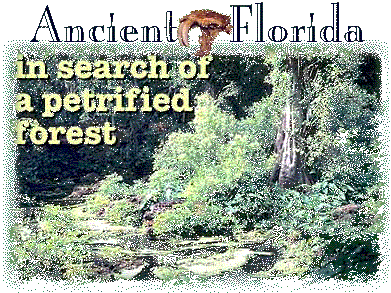<- Color - More Absolutely Florida
<-- More Ancient Florida
|
|
 By Mark Renz Sometimes you can't see the ancient forest for the trees. But they're there, if you know where to look. My search for petrified wood in Florida led me to the Peace River in Polk and Hardee counties (digging in the shallow, gravelly bottom) and the Cargill Mine in Polk County (searching through piles of sediments left over from draglines).
There are similarities between tusk and ivory. Ivory, like wood, is layered. If you were to look at the outside of a tusk, you would see rings which indicate the edges of growth cones, although it is doubtful that a ring would represent one year. Throughout a mammoth's life the tusks sometimes grew quickly, others times slowly. A lot of trees on the other hand have rings which do indicate a year in its life. Another similarity is their color, which is--at least in the creeks and rivers I frequent--usually light or dark brown. (Specimens I found in a Polk County phosphate mine however were white, sometimes with brown and bluish-black colors running through the middle.) I consulted with Dr. Steven Manchester, associate curator of Paleobotany at the Florida Museum of Natural History, and the professor in the Botany Department of the University of Florida in Gainesville, about where to find the various species of trees in the Sunshine State. Just about everywhere, he told me, although very little of it has made its way to the Florida Museum of Natural History in Gainesville for analysis. Only about 30 specimens are in their collection. For a list of sites, click here , (authored by Dr. Manchester.)
The finds were pine (pinus), oak (Quercus) and walnut (Juglans). In a phone conversation with Dr. Manchester, he explained that walnut doesn't grow this far south today. "It's exciting to think about," he said, "It suggests that the boundary was further south, although I'm hesitant about saying that. Some species grow as far as some of the islands in the Caribbean and Brazil. The black walnut, for instance, went all the way to Brazil." Dr. Manchester said that the walnut trees suggest the climate may have been a bit cooler in the Miocene, that its range was 100 or 200 miles further south than originally suspected. 2) Santa Fe River- 3) White Springs - I'm not sure why, but I don't find petrified wood in every Florida creek or river I investigate. Perhaps I'm not looking in the right place, or deep enough, or the sediments aren't old enough, or the preserving mineral contents are insufficient, or the area I'm searching has never had enough trees growing to become petrified--only shrubs and grasses. Distinguishing tusk from wood If you think you've come across a large section of tusk, it's probably best that you take some precautions and wrap it first in some kind of protective bandaging or in a plaster jacket (for dry land finds). Keep it immobile at home until you're ready to attempt preserving it. If the tusk is broken, you should be able to see distinctive layers running horizontally, and on either end there will be an equally distinctive cross-hatch pattern. A lot of petrified wood will also have layers running horizontally, but it is generally much heavier--more like solid stone--and will not have the cross-hatch pattern on the ends. Is it wood or is it Memorex? Often times in creeks and rivers, you may come across waterlogged branches or partial trees buried in muck or sand, or even protruding out of soft limestone or clay. It's very difficult to tell without lab analysis the age of such material. But wood like this can be very old--hundreds, thousands, even millions of years. According to Manchester, two categories of wood are found in the petrified record: casts and permineralizations. When wood is buried quickly in either case, low oxygen levels retard fungal and bacterial breakdown. For wood to become a cast, minerals and other material fill in the spaces left behind as the original wood decays. A cast will leave the outside form of the wood, but lose the cell structure, making it tough to identify the individual genus or species. Permineralized woods occur when the mineral in ground water soaks into the wood, filling the spaces within and between cells, which preserves the entire tissue. With the original cell structure still intact, it's easier then to identify the genus or species. Telling them apart If you'll look at Dr. Manchester's Web site or find the earlier mentioned article with the same information, he has a number of excellent photographs which show transverse sections of different Florida petrified woods. According to Dr. Manchester, conifers (softwoods) and angiosperms (hardwoods) can be identified using a hand lens. Conifers should have narrow elongate cells. Because they don't have vessels (pores) their wood will look smooth and even. Angiosperms have vessels and fibers. Both generally show growth rings in cross sections. Woods like palm won't. Dr. Manchester suggests collectors compare petrified woods with modern woods through literature on anatomy of commercial timbers (Gregory, 1980; Hoadley, 1990). If you want to be more certain, send small samples (or quality close-up photos of the samples) to him at the Department of Natural Sciences, Florida Museum of Natural History, Dickinson Hall; Museum Rd. and Newell Dr., P.O. Box 117800 University of Florida, Gainesville, FL 32611-7800. It might be a good idea to call (352/392-1721) or e-mail him first. Keep good field notes when you find petrified wood. Jot down the location, note if it was part of a permanent sediment or lying loose and jumbled up with other material as a result of wash-out or digging? How much wood was at the site? |